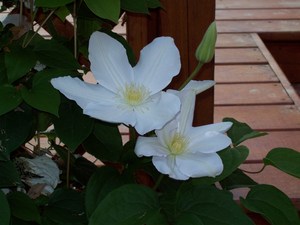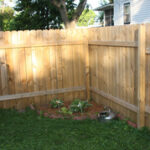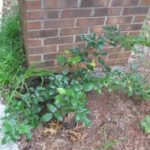Decorate a lamp post, a barn post, a fence, or a trellis with a flowering annual vine and enjoy an explosion of patterns and colors from spring to fall. Annual vines are easy to grow and don’t have to climb: They can also stand in for an eye-pleasing rambling ground cover or fill a container. I have a Blue Picotee morning glory in a wooden barrel turned on its side. It fills the container, climbs through the slats in the barrel, covers the ground in front and shoots blooms up above and around the barrel. Another morning glory plant is happily climbing a more traditional trellis, decorating a corner of a window in front of our house.
What annual vines are easy to grow? What are the best annual vines to grow from seed? Fortunately, most annual vines are super easy to grow from seed. Here’s a description of some of the best:
Morning Glories:
While there are varieties of morning glory that grow by themselves, there are also some very beautiful varieties that have been cultivated and are available in seed packets. Blue Picotee boasts a deep purple-blue flower that looks like a star because of its petals’ pointy tips. They can be single or double. Grandpa Ott’s is an heirloom variety featuring a deep blue flower with a faint red or fuschia star pattern in the middle. Morning glories come in pleasing mixes of color too, so you can enjoy many different colors in one garden. Moonflower is a variety of morning glory that blooms later in the day and releases a fragrance that wafts around your porch in the evening. Other varieties to look for? Try Crimson Rambler, Blue Star, Flying Saucers (huge blooms) or Heavenly Blue, to name several. Plant in full sunshine or start indoors before the last frost then transplant into a sunny spot. Make sure they have a post, trellis or fence handy for climbing!
Black Eyed Susan Vine:
These are available in different color selections, varying from yellows and oranges to shades of pink. The Black Eyed Susan vine can be started indoors a few weeks before the last frost so you can enjoy blooms as early in the season as June. This is a vine that is just as happy to adapt to ground cover status as it is to climb riotously up a fence or a trellis.
Cardinal Climber and Cypress Vine:
I mention these together only because I always grow them together. They grow to about the same height (8-10 feet) and their delicately lobed leaves look terrific growing in tandem. Fast growing and hardy, these two vines bloom profusely with small bell-shaped red flowers (Cardinal climber) and pastel pink, white and red smaller bells on the cypress vine. They bloom earlier if started inside, and appreciate lots of water in a nice sunny spot.
Hyacinth Bean Vine:
This is one of my favorites. Several years ago I was visiting a friend whose front porch posts were covered with the tall purple sweet-pea type flowers of the Hyacinth Bean vine. I told her how much I liked her front porch vine, and later that year she gave me an envelope full of seeds from her vines. The next summer my mother saw the vine blooming on my back porch and told me that her mother had grown that flower in her back yard throughout her childhood. That did it for me. Ever since, the Hyacinth Bean vine has been a must-have in my gardens every year. Once you find a source for the beans, your vines will produce handsome purple bean pods each year, and you can harvest and store the seeds yourself year to year. Start them indoors before the last frost or just plant right in the ground after the last frost in the spring. Hyacinth Bean Vine is really good at reseeding itself, so if you have a permanent spot for it, just bury some pods each fall and you will find the vines coming up on their own the following spring. They will grow to incredible heights, and always please the eye with their huge heart-shaped leaves, spikes of purple flowers, and shiny purple bean pods. Don’t miss out on growing them!
Climbing Nasturtiums:
These are great for low fences and marvelous as ground covers. There are many varieties – bright or darker flowers, glowing lime green leaves or forest green dark leaves – look around to find your favorite. Be sure to read the packet and make sure they are climbing nasturtiums and not the bush variety. Nasturtiums don’t like to be disturbed and grow very quickly, so don’t start them inside. Plant them directly in the warm ground after the last frost and keep watered until established.
Sweet peas:
Sweet peas are a traditional vine treasured by generations of gardeners. They are natural fence-climbers. I think they’re pretty enough to deserve their own little section of white picket fence to grow on, but put them anywhere there is a fence to be conquered and they won’t disappoint you. An added bonus is the sweet fragrance.
Scarlet Runner Bean: This fast-growing climber is attractive vine that can climb to rooftop heights, and is a traditional feature of the famous gardens at Monticello, Thomas Jefferson’s Virginia estate.
There are more annual vines out there, but these are arguably the easiest to grow and the most popular. Look around, be creative and turn your next garden into a cascade of beautiful, fragrant, rambling flowers!
Sources:
Better Homes and Gardens’ Complete Guide to Gardening, 1979 Meredith Corporation. Pages 161-164
DIY Network on vines: http://www.doityourself.com/stry/trumpetvine
Hatch, Peter J., The Gardens of Thomas Jefferson’s Monticello, Thomas Jefferson Foundation.





